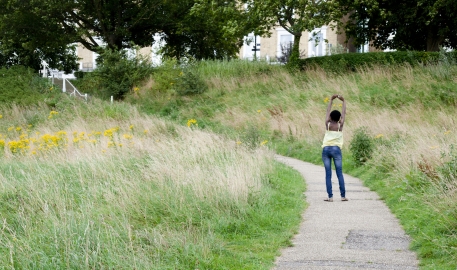Monday – Friday 9am to 5pm
Posture and positioning
Posture is more important than many people realise. Sitting or standing in the right position helps to make sure our bodies function properly.
When standing or sitting; good posture uses less energy than poor posture. Poor posture uses high amounts of energy, which means our bodies need to rest for longer to recover. Some people with scoliosis might find good posture difficult. Often someone with scoliosis will lean forwards and to the side either slightly or a lot. They will often try to avoid doing this, which can lead to slightly bent knees and the pelvis tilting backwards.
The ideal posture when standing is to have weight evenly spread. That way each joint bears an even amount of pressure. Joints are the places in the body where two bones meet. The neck should be straight with no tilt, the hips level, and the pelvis neutral (this means not tilting forward or backwards). The knees should be straight or alternatively one knee straight, the other slightly bent. It can help to check your posture regularly in the mirror, or get others to check it for you. Imagine yourself as a puppet with a string attached to the top of your head pulling you straight.
Poor posture can put a strain on the body causing pain and muscle tightness or weakness. It can also change the way you move. These changes can mean you aren’t able to move as much or in as many different ways.
When you have scoliosis it may be difficult to be in the most ideal posture but it is advisable to get as close to it as possible.
Sitting posture
Try to sit back in a chair with your weight on your buttocks and thighs and your back straight. Try not to sit forward on the edge of your seat and keep the pelvis neutral (not tilting forward or backwards). The best height for the chair is between 18 and 22 inches depending on how tall you are.
Try to sit with your knees slightly lower than your hips. Keep feet flat on the floor and shoulder width apart. Try not to sit for too long at any one time. It is best to move every 30 minutes.
Try to get a chair that suits your needs, such as having lumbar (lower back) support, cushions, or memory foam. A balans (kneeling) chair can help to make you more aware of slouching, but can be painful on your knees.
AVOID: Low soft sofas, chairs without arms, chairs that are too low or too high, bucket chairs, deep chairs.
Beds and sleeping
Choosing the right bed is very important as you spend around 8 hours of the day in it. If you are comfortable you are more likely to sleep well. Getting enough sleep is very good for your health.
A good height for a bed is 18- 22 inches. This should make it easier to lie down and get up. Make sure you try before you buy. Just because a bed is recommended, or said to be good for back health it still may not be right for you.
The mattress should not be too hard or too soft. It needs to support your weight without sagging or giving way at the hips and shoulders. Duvets are easier to use than sheets and blankets, and fitted sheets are recommended. The base of your bed should be 30 centimetres thick and should not have wooden slats. It is also best to have pillows which support your neck.
The best way to get into bed is to use something called the log rolling technique:
- Sit on the bed
- Lean on arms and lift legs onto bed
- Turn onto back with legs together
*Reverse the steps to get out of bed.
Avoid:
Sleeping flat on back with legs straight because this puts strain on the lumbar (lower) spine
Too many pillows
Sleeping on your front
Try:
Sleeping on your back, with your knees bent and a roll support
On your side with your leg bent forward
On your side with a pillow between your legs or under your knees for better support In the fetal position.
Keeping the pelvis neutral
The pelvis is the large frame at the bottom of the spine. The legs are attached to it. Keeping the pelvis neutral means it is not tilting forward or backwards. A helpful trick to do this is to imagine the pelvis is a bucket of water. If the pelvis tilts forward the water would spill out of the front of the bucket and if the pelvis tilts backwards water would spill out of the back. Only when the pelvis is neutral will the bucket be level and no water spilt. Many adults with scoliosis will not be able to achieve this posture but it is advisable to get as close to it as possible.
If you would like to talk further about any aspect of scoliosis, SAUK is here to help; please call our helpline or contact us via post or using our e-mail address info@sauk.org.uk.
© 2024 Scoliosis Support & Research | Scoliosis Support & Research is a registered charity no. 1181463
Website design & development by Pedalo

